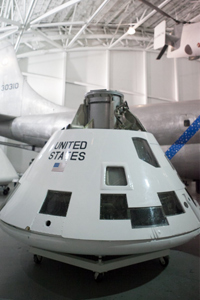What does it take to turn a spaceship into a museum piece?

Spacecraft are a unique culmination of humankind’s technological ingenuity. They require untold millions of dollars and man hours to build and are jammed with bleeding-edge gadgetry. And then one day they are simply outdated … and out of work.
Then, some of these once-glorious spaceships start their second lives as celebrities and star attractions at museums. But how exactly does a ship that once roamed the stars become an Earth-bound attraction suitable for long-term public viewing?
It starts, of course with an acquisition process. If you’re in charge of a museum looking to score a major piece of space history, it helps to know exactly what piece you need to flesh out your collection. Perhaps you’re looking for just a few artifacts that traveled to the moon. Or maybe you’re audacious enough to ask for an entire space shuttle.
You might start by inquiring directly with NASA or a related space agency that’s in possession of said objects. In some instances, you might even approach a private collector who had the means (and cash) to acquire a spacecraft.
There’s a lot of competition for decommissioned spaceships, so the process almost invariably is much more formal and requires a lot of planning and paperwork. If you happen to run one of many private space museums, it’s unlikely NASA will just donate one of their old machines to you. In that case, the piece is loaned for a predetermined amount of time.
That is, of course, unless you happen to run the Smithsonian. Because the Smithsonian is another government-run facility, the spacecraft is simply transferred from one agency to another, again, for a specified duration.
There’s more work involved if you want a limited-edition item like a space shuttle. For these crown jewels, NASA set forth strict requirements. They wanted each shuttle to have the largest possible audience (meaning a museum near a large metro area), as well as a state-of-the-art display facility. Each recipient also had to pony up a galaxy-sized pile of money for display preparations and transportation costs.
Of course, smaller craft and individual pieces of space gear are much easier to come by. So, play your zero-gravity space chips just right and you might land a lunar lander (or a copy, anyway). But the work to make that piece museum-ready — and to transport it to its display hall — well, that part takes a space-age-type effort.
1
(current)
2
…
4
Before a space agency lets any transportation workers even touch a spacecraft, they have to make sure it won’t hurt anyone or cause a national security incident. So engineers carefully scour the craft and remove and replace certain parts.
Hazardous materials are among the first to go. They drain fuels and lubricants and pull the associated tanks, too. Gas-related systems, like oxygen tanks, must be taken out as well.
Security issues are also a concern. Engineers remove high-tech items too classified for the public eye.
And workers often strip out parts that are still usable in other craft. After doing so, they may replace those components with replicas so that viewers get a sense for what the ship really looked like.
For the space shuttles, entire sections of the crafts were eviscerated for reasons other than safety. Engineers wanted to examine how years of spaceflight had affected various systems. For example, they removed and dismantled the engines to understand how well they endured their workloads. They even took out the windows to better see how the materials had fared.
Once a craft finally gets the green light for transport, well, you can’t use a Star Trek transporter to magically whisk a spacecraft from a landing field to a museum. And when you’re talking about moving a hulking, massive spaceship from Point A to Point B, things can get tricky in a hurry.
It all depends on size and transportation options. The Smithsonian and National Museum of the United States Air Force, for example, are adjacent to active landing strips, meaning that larger craft can just land nearby and then taxi directly into display hangars.
With smaller craft, it’s sometimes possible to partially disassemble them and then transport them via highway. In these situations, a transport company (such as a trucking company) works directly with the space agency to understand the weight and size of the parts that need to be moved. Then the trucking crew works out the logistics of getting each section of the craft to its final destination.
Keep reading and you’ll see more about how spaceships navigate their



 Creators of mankind
Creators of mankind Description of “Tall white aliens”
Description of “Tall white aliens” Where they came from?
Where they came from? About hostile civilizations
About hostile civilizations The war for the Earth
The war for the Earth “Tall white aliens” about eternal life
“Tall white aliens” about eternal life Video: “Nordic aliens”
Video: “Nordic aliens” Aliens
Aliens Alien encounters
Alien encounters The aliens base
The aliens base UFO
UFO Technology UFO
Technology UFO Underground civilization
Underground civilization Ancient alien artifacts
Ancient alien artifacts Military and UFO
Military and UFO Mysteries and hypotheses
Mysteries and hypotheses Scientific facts
Scientific facts


















